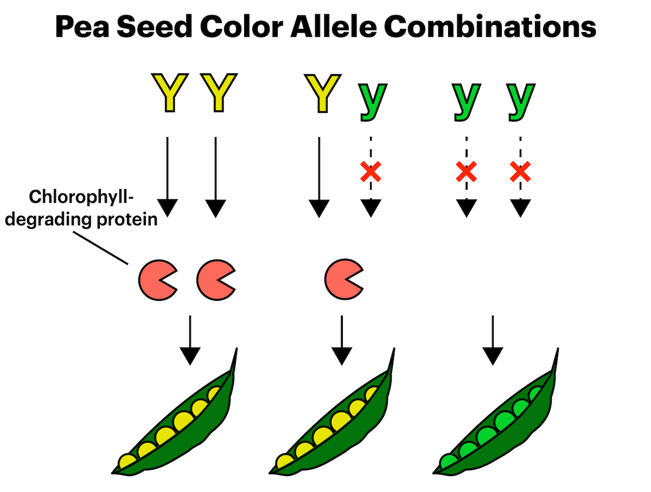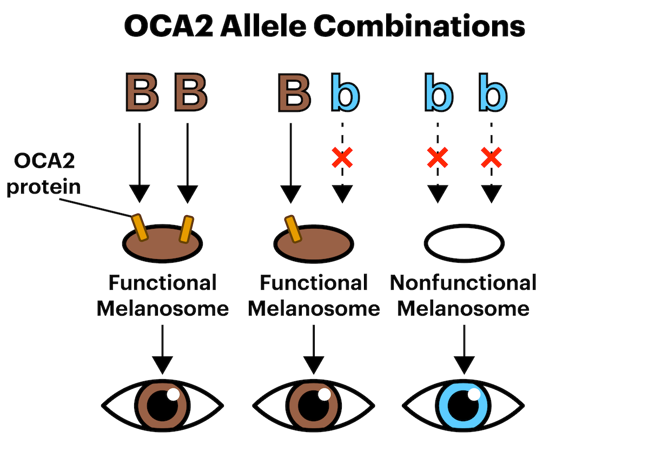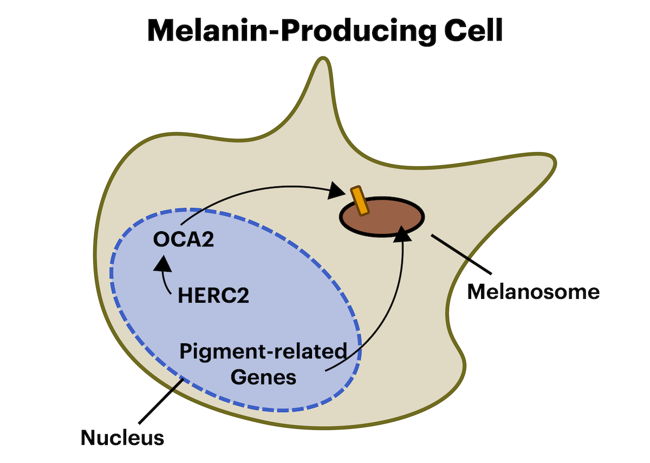
What makes a trait dominant?
April 5, 2024

- Related Topics:
- Dominant and recessive,
- Genes to proteins,
- Classical genetics
A curious adult from South Carolina asks:
"What determines which of the 2 sets of genes are the dominant ones? Like, what makes a gene dominate over the other one? Is there some kind of battle going on for dominance?"
While picturing genes in a battle for dominance paints a funny picture, that’s not quite how it works. Let’s talk more about dominant and recessive traits!
Discovering dominance with peas
We know that children have similar traits to their parents, but how does that work? This question was first studied back in the 1800s by Gregor Mendel, who studied pea plants.
Mendel observed that when a plant with yellow seeds was bred with one with green seeds, the offspring had yellow seeds. The yellow seed version tended to dominate over the green seed version.
After observing several traits like this, Mendel came up with some explanations for how traits are passed down. He proposed that peas have two sets of genetic instructions (genes!), one from each parent. These genes come in different versions (like yellow vs green seeds), which we now call alleles. Which two alleles a plant has determines the final trait.
Two green seed alleles make a plant with green seeds. Two yellow seed alleles make a plant with yellow seeds. If a plant has one green and one yellow seed allele, the dominant yellow allele prevails and leads to yellow seeds.
Mendel’s framework for understanding traits was essential in establishing the field of genetics. However, Mendel had no idea what an allele physically was. Our understanding of alleles has come a long way since then. We now know that alleles are different versions of genes in our DNA. The alleles that Mendel was observing in his peas were actually genes that instructed the peas on how to produce certain colored seeds.
But this still doesn’t answer the question of why some versions of genes ‘dominate’ over others!
Why yellow seed color is dominant
Genes are instructions for your cells to produce specific proteins. Proteins are often the reason why we see certain traits in an organism.
The alleles for pea seed color are different versions of the stay green gene. This gene is instructions for a protein that degrades chlorophyll, which gives peas their green color.
The yellow seed allele produces a protein that degrades chlorophyll, which causes the seeds to turn yellow. The green seed allele produces a defective version of that protein, which keeps the seeds green.
But remember, each pea contains two copies of this gene! It turns out just one copy of the chlorophyll-degrading protein is enough to fully break down chlorophyll. This is why the yellow seed allele is considered dominant.

Is it always this simple?
Not all traits are that simple! Let’s consider the example of eye color. If Mendel were to describe eye color, he would say the brown eye allele is dominant over the blue eye allele. This is true most of the time but can’t explain eye color fully. Let’s dive into the specifics!
The color in brown eyes comes from a pigment called melanin. Melanin is produced inside cells in small factories called melanosomes. People with blue eyes have lower amounts of melanin, causing their iris to reflect mostly blue light (similar to why the sky looks blue!)
For the most part, the amount of melanin in someone’s eyes is determined by a gene called OCA2. This gene makes a protein involved in keeping melanosomes operational.
The OCA2 gene comes in several different versions (alleles). One allele makes proteins that are a bit weaker than their brown eye counterparts. These weak proteins are not great at keeping melanosomes running, causing less pigmentation and blue eyes.
But don’t forget, our cells have two copies of each gene. If someone has both a strong and a weak allele, then proteins are made from both. In this case, the stronger protein can do all the heavy lifting on its own, resulting in full pigmentation and brown eyes. Blue eyes only happen when both proteins are the weaker version.

Because the brown eye allele ‘overrides’ the blue eye allele, this seems to match how Gregor Mendel described allele dominance. It’s tempting to say the brown eye allele is dominant.
However, that’s not the end of the story. There are many other genes that affect eye color.
For example, HERC2 influences eye color in a very different way from OCA2. The HERC2 gene contains a section of DNA that is important in turning on the OCA2 gene. If this region is mutated, then OCA2 can’t be turned on, and eyes don’t get pigmented regardless of the OCA2 allele. Even one copy of the activating-version of HERC2 is enough to turn on OCA2, making it dominant over the non-activating allele.
While HERC2 and OCA2 are involved in shuttling pigment around in cells, other genes play a role in producing pigment. Different versions of these genes may result in lighter or darker pigment.
Now that HERC2 and other pigment-related genes are in the picture, eye color just got a lot more complicated. And we haven’t even started talking about green eyes!
When we consider the complex network of genes that influence eye color, our notion of ‘dominant’ and ‘recessive’ struggles to apply. Alleles can often be good predictors of a specific trait, but don’t always explain the whole story. To fully understand how an allele can result in a trait, we need to understand the cellular machinery that determines that trait.

Why are we still learning about Gregor Mendel then?
While Gregor Mendel’s view of genetics may be overly simplistic at times, it allows us to discuss patterns in how alleles create traits. These patterns may not always hold true but can be useful in predicting how traits may get passed between generations.
Mendel’s work founded the field of genetics. However, our knowledge has come a long way. We now have the tools to understand the exact mechanism by which alleles create traits. As we look deeper into these mechanisms, we realize they are a messy, tangled interaction of genes. The idea of allele dominance doesn’t always apply.

Author: Raleigh Slyman
When this answer was published in 2024, Raleigh was a Ph.D. candidate in the Department of Mechanical Engineering, studying human embryo organization in Ovijit Chaudhuri’s laboratory. He wrote this answer while participating in the Stanford at The Tech program.
 Skip Navigation
Skip Navigation
